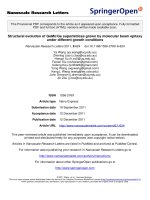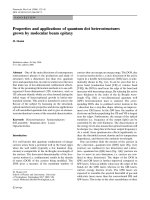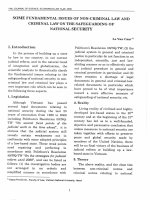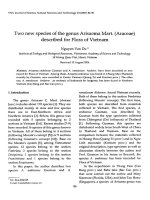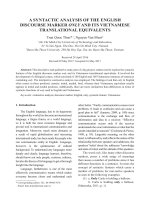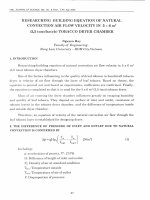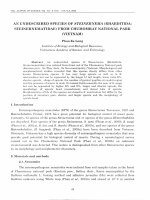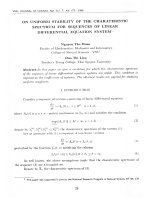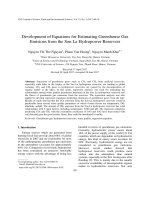DSpace at VNU: Comparative optical study of Eu3+ ions doping in InGaN GaN quantum dots and GaN layer grown by molecular beam epitaxy
Bạn đang xem bản rút gọn của tài liệu. Xem và tải ngay bản đầy đủ của tài liệu tại đây (230.66 KB, 5 trang )
Optical Materials 28 (2006) 775–779
www.elsevier.com/locate/optmat
Comparative optical study of Eu3+ ions doping in
InGaN/GaN quantum dots and GaN layer grown by
molecular beam epitaxy
Thomas Andreev a,*, Nguyen Quang Liem a,b,c, Yuji Hori a,d, Mitsuhiro Tanaka d,
Osamu Oda d, Bruno Daudin a, Daniel Le Si Dang e
a
b
CEA/CNRS/UJF Research Group Nanophysique et Semiconducteurs, DRFMC/SP2M/PSC CEA-Grenoble,
17 rue des Martyrs, 38054-Grenoble Cedex 9, France
Institute of Materials Science (IMS), Vietnamese Academy of Science and Technology, 18 Hoang Quoc Viet, Cau Giay, Hanoi, Vietnam
c
College of Technology, Hanoi National University, 144 Xuan Thuy, Cau Giay, Hanoi, Vietnam
d
NGK Insulators, LTD 2-24 Sudacho, Mizuhoku, Nagoya, Japan
e
CEA/CNRS/UJF Research Group Nanophysique et Semiconducteurs, Laboratoire Spectrome´trie Physique (CNRS UMR5588),
Universite´ J. Fourier, BP 87, 38402 Saint Martin dÕHe`res, France
Available online 2 November 2005
Abstract
We report on a comparative optical study of InGaN:Eu quantum dots (QDs) and GaN:Eu layer grown by molecular beam epitaxy
(MBE). Analysis of the 5D0 ! 7F2 transition as a function of the excitation wavelength shows that Eu3+ ions in InGaN:Eu QDs are
located inside InGaN QDs and also in the GaN barrier layer. The existence of Eu3+ ions in the GaN barrier layer is explained by
Eu segregation/diffusion during growth. For Eu3+ ions located inside InGaN QDs the photoluminescence (PL) shows only a slight
decrease with temperature from 5 K to 300 K. In contrast, the PL from Eu3+ ions in the GaN barrier layer or in GaN thick layer shows
a much more pronounced thermal quenching.
Ó 2005 Elsevier B.V. All rights reserved.
1. Introduction
The combination of rare earth (RE) luminescence with
the wide band gap of (In)GaN is a promising solution
for full color devices, since efficient energy transfers can
occur from carriers of the semiconductor host to the RE
excited states. Successful RE doping of GaN films was
demonstrated by several groups (see for instance Ref. [1–
3]) either by implantation or by molecular beam epitaxy
(MBE) growth.
To reduce the nonradiative recombination channels
derived from the high dislocation densities in GaN layers
we propose to combine the confinement properties of
quantum dots (QDs) with the RE luminescence to achieve
*
Corresponding author. Tel.: +33 438 78 5416; fax: +33 438 78 5797.
E-mail address: (T. Andreev).
0925-3467/$ - see front matter Ó 2005 Elsevier B.V. All rights reserved.
doi:10.1016/j.optmat.2005.09.061
high luminescence even at room temperature. We have
already demonstrated Eu- (red), and Tm- (blue) doped
GaN QDs embedded in an AlN matrix, which showed
stable luminescence in the temperature range of 5–300 K.
Furthermore a strong enhancement of the radiative quantum efficiency, by about one to two orders of magnitude
as compared to rare earth doped films, was observed at
room temperature [4–6].
However the injection of carriers into AlN is hindered
by the difficulties in p-type and n-type doping of AlN, so
that one solution could be to use RE doped InGaN QDs
grown on GaN for current injection devices, since p- and
n-doping of GaN are well controlled by MBE. Eu was
found to act as a surfactant in MBE growth of GaN layers,
leading to drastic changes in adatom kinetics, as we demonstrated already in Ref. [7]. For Tm-doped GaN QDs in
AlN, we found that Tm is located inside GaN QDs, but
776
T. Andreev et al. / Optical Materials 28 (2006) 775–779
also at the GaN/AlN interface [5]. Such a situation could
happen also in the case of Eu doping in InGaN/GaN
QDs due to the complex interaction of RE atoms with
the formation of QDs.
Hence the aim of this article is to address the locations,
PL efficiency and thermal quenching property of Eu3+ ions
in InGaN/GaN QDs and to compare to those in GaN
layer.
2. Experimental
The growth was performed on 1 lm thick AlN pseudosubstrates deposited by metal organic chemical vapor
deposition on c-sapphire [8]. After a standard chemical
degreasing procedure and acid cleaning with HF, the
pseudo-substrate was fixed with an indium bonding on a
molybdenum sample holder, and introduced in a MBE
chamber equipped with Al, Ga, In and Eu effusion cells
and a radio-frequency plasma cell to produce monatomic
nitrogen. The growth conditions were controlled with
reflection high-energy electron diffraction, which allows
in situ and real time monitoring the 2D–3D transition
corresponding to the formation of self-organized QDs.
The InGaN QDs were grown at 600 °C following the
Stranski-Krastanow (SK) growth mode, i.e. the QDs
appear after the deposition of a wetting layer of typically
two monolayers [9]. To allow the QD growth in SK growth
mode of InGaN QDs on GaN, a minimal In concentration
of around 20% is needed. Before the growth of InGaN
QDs, a 150 nm thick GaN buffer layer was deposited at
720 °C. During growth of InGaN, the shutter of Eu source
was opened to dope the material. Then, the QDs were
capped with about 8 nm of non-intentionally doped
(n.i.d.) GaN. This process was repeated 165 times to
achieve stacks of QD planes sandwiched in GaN barriers.
From chosen growth conditions we estimate an Eu content
of 1%.
For reference measurements, a GaN:Eu layer was grown
on a n.i.d. GaN buffer. The Eu concentration of the GaN
film reference sample was measured by RBS to be about
0.2%. Morphology of the grown sample has been studied
at room temperature in air with an AFM Dimension
3100 microscope.
PL spectra were measured using a tunable excitation
source consisting of a 500 W high-pressure Xe lamp
equipped with a Jobin-Yvon high-resolution double-grating monochromator (Gemini 180). The excitation power
density was about 200 lW/cm2 at 350 nm. The PL was
analyzed by another Jobin-Yvon grating monochromator
(Triax 550) and detected by a CCD camera operating at
liquid nitrogen temperature. The sample was mounted on
the cold finger of a micro-cryostat which enabled us to
record PL spectra at various temperatures from 5 K to
380 K.
3. Results and discussion
Fig. 1 shows AFM images of InGaN:Eu QDs in different areas from 4000 · 4000 nm2 to 500 · 500 nm2. The surface morphology is characterised by the typical spiral
Fig. 1. AFM images of InGaN:Eu QDs. Areas of images: (a) 4000 · 4000 nm2, (b) 2000 · 2000 nm2, (c) 1000 · 1000 nm2 and (d) 500 · 500 nm2.
hillocks of GaN (Fig. 1a and b). InGaN:Eu QDs are found
aligned on the atomic terraces around the hillocks as visible
in Fig. 1b–c. The higher resolution image of Fig. 1d shows
the InGaN:Eu QDs, which present diameters between
15 nm and 40 nm and rather small height, between
0.4 nm and 1 nm. The quantum dot density was found to
be around 1.4 ± 0.2 · 1011 cmÀ2.
Fig. 2a shows room temperature PL spectra of InGaN:Eu QDs and a GaN:Eu layer excited at 360 nm. Stark
split lines can be observed, corresponding to the 5D0–7F2
transition of Eu3+ ions. The three main lines in the two
spectra are located at 620, 622 and 633.5 nm. According
to the spectroscopic analysis of Brecher et al. [10] emission
at 633.5 nm is from the 5D1 ! 7F4 transition. The line
width is slightly broader in the case of InGaN QDs as
618
621
6 24
627
630
633
636
resulting from internal electric field and strain inside
InGaN QDs or poorer crystalline quality. A remarkable
difference between the two spectra is the larger intensity
of the 622 nm line in doped QDs, whereas the 620 and
633.5 nm lines display the same intensity ratios. This suggests two contributions of Eu3+ ions to the PL of InGaN:Eu QDs, which come from Eu3+ ions in the InGaN
material and in the GaN barriers. Note that Eu3+ ions
might occupy different sites in the two structures (InGaN
and GaN), which can explain the modification of the spectrum [11]. It is interesting to note that Eu was observed to
exhibit a tendency to segregate on the surface during the
growth of GaN and AlN, so that it is quite possible that
a small amount of Eu content can be found also in the
GaN barrier when doping InGaN QDs [7]. We believe that
in the PL of InGaN:Eu QDs, both contributions from
Eu3+ ions in InGaN QDs and from Eu3+ ions in the
GaN barrier layer are superimposed. Notice that for Tm
doping of GaN QDs grown on AlN the situation is even
more complex as Tm3+ ions are found inside QDs and also
at the GaN/AlN interface [5].
To assess further the origin of emission lines, PLE
measurement was carried out at 5 K as shown in
Fig. 2b. The GaN:Eu layer exhibits rather similar PLE
spectra for emissions at 620, 622, and 633.5 nm (not
shown). The PLE spectra are characterised by band-toband absorption at the GaN band gap and a weak
absorption tail below band gap down to 400 nm, which
could be due to defect states. However, no well-resolved
absorption due to a trap level at 400 nm as previously
reported in Ref. [2] could be observed in our structures,
which illustrates the complexity of carrier-mediated
energy transfer processes in semiconductors doped with
RE ions. For InGaN:Eu QDs the PLE spectra measured
for the 620 and 633.5 nm emission lines (not shown) are
similar, but they differ from that measured for the emission at 622 nm. In the later case, the peak absorption is
at lower energy and the low energy absorption tail below
380 nm is much stronger. This different behaviour is consistent with our assumption that the 622 nm emission
observed in InGaN:Eu QDs is to be associated to the
Eu3+ ions other than those responsible for the 620 nm
and 633.5 nm emissions. More precisely we assign the
622 nm line (or the main part of it) to the Eu3+ ions
located in InGaN QDs, and the 620 nm and 633.5 nm
lines to the Eu3+ ions located in the GaN barrier layer.
In fact, a recent PL study of Eu doping in GaN/AlN
QDs showed that only the 622 nm line could be observed
for Eu3+ ions in GaN QDs, by contrast to Eu3+ ions in
GaN layer which exhibit three emission lines at 620, 622
and 633.5 nm (Fig. 2). At present there is no clear explanation for the very different optical signature of Eu3+ ions
at these two types of locations. However, it is reasonable
to assign them to the different site-symmetry/ligand of
Eu3+ ions.
For InGaN:Eu QDs, the bump marking the beginning
of band-to-band absorption in PLE spectra is at lower
778
T. Andreev et al. / Optical Materials 28 (2006) 775–779
5
λ exc = 400 nm
(a)
PL intensity (arb.units)
PL intensity (arb.units)
5K
InGaN:Eu QDs
GaN:Eu layer
618
620
622
624
390 nm
x 100
471.5 nm
615
620
625
630
635
640
Wavelength (nm)
Wavelength (nm)
Fig. 3. PL spectra of InGaN:Eu QDs (upper spectrum) and GaN:Eu layer
(lower spectrum) with the 400 nm excitation at 5 K. The vertical dotted
lines guide to the eye.
1
0.1
300 K
PL intensity (arb.units)
energy than the GaN gap. This can be explained by In diffusion of about 1% into the GaN spacing layer or strain
effect of the GaN spacer as it was grown onto the InGaN
QDs. On the other hand the PLE spectrum of the 622 nm
line of InGaN QDs shows a remarkable strong absorption
at 365 nm with respect to band-to-band absorption and
pronounced low energy tail absorption below the band
gap. All these features can be assigned to absorption in
an inhomogeneous ensemble of QDs with a distribution
in size and shape (see the AFM images in Fig. 1).
An excitation wavelength of 400 nm (below the band
gap of GaN) was used to obtain the 5 K PL spectra from
InGaN:Eu QDs and a GaN:Eu layer shown in Fig. 3.
The PL integration time was longer by two orders of magnitude in the case of the GaN layer as compared to InGaN
QDs. This shows that defect related excitation mechanism
is very weak in our GaN layer and that a significant part of
the InGaN QD distribution can be still excited at 400 nm.
The 5D0 ! 7F2 transition displays only emission at around
622 nm consisting of two sharp lines with FWHM smaller
than 0.3 nm. A small blueshift by about 0.1 nm as well as a
spectral broadening are observed for emission from InGaN:Eu QDs, which could be induced by electric field
effects or the different environment of Eu in the InGaN
QDs and in the GaN layer. Fig. 4a compares the PL of
InGaN:Eu QDs at T = 300 K, using different excitations
above (360 nm) and below (390 nm and 471.5 nm) the
GaN band gap. Using 390 nm as excitation wavelength,
hardly any emission at 620 nm or 633.5 nm can be detected,
since Eu atoms in the GaN spacing layer are not excited, in
agreement with the PLE results. The total emission intensity is higher in the case of excitation above the barriers
(360 nm) due to stronger absorption into the GaN barrier
and carrier diffusion from the barriers into the QDs.
We now discuss the different thermal quenching characteristics originating from different Eu3+ ion locations. In
300 K
360 nm
610
626
7
D0→ F2
0.01
360 nm
390 nm
(Eact,1=70 ± 5 meV)
(Eact=220 ± 20 meV)
10
(b)
100
1000/T (1/K)
Fig. 4. (a) PL spectra from InGaN:Eu QDs measured with different
excitation wavelengths (indicated at the curves) at 300 K. The spectra are
normalized by the excitation power density and the accumulation time.
The 471.5 nm spectrum is multiplied by a factor 100 for clarity. (b)
Temperature-dependent PL of InGaN:Eu QDs for emissions at 622 nm
between 5 K and 380 K in double logarithmic scale. The excitation
wavelengths were 360 nm (filled dots) and 390 nm (filled squares). The
dashed lines are used simulations to get thermal activation energies. The
corresponding activation energy is also indicated in the figure. The vertical
line marks 300 K for clarity.
Fig. 4b the temperature dependence between 5 K and
380 K of the 622 nm emission is shown with exciting at
360 nm for InGaN:Eu QDs (above the corresponding
InGaN band gap) and 390 nm for the GaN spacing layer
(below its band gap). A reduced thermal quenching can
be found for excitation below GaN gap. This is due to
the fact that electron and hole pairs are directly injected
and confined in QDs, which should strongly reduce their
capture by non-radiative recombination centres at elevated
temperatures. Furthermore the weak thermal quenching
suggests that the carrier mediated energy transfer to RE
ions in QDs should be faster than non-radiative recombination channels experienced by carriers in QDs, which
T. Andreev et al. / Optical Materials 28 (2006) 775–779
are found to be on a time scale of 1 ns for carriers in GaN/
AlN QDs as reported by Simon et al. [12].
4. Conclusion
In conclusion, InGaN:Eu QDs imbedded in GaN barriers have been studied by PL and PLE at various temperatures. The analysis of the 5D0 ! 7F2 transition as a
function of the excitation wavelength has shown that
Eu3+ ions are located inside InGaN QDs and in the GaN
barrier layer as well. Emission from Eu3+ ions inside
InGaN QDs showed only a slight decrease from 5 K up
to room temperature. In contrast, the PL from Eu3+ ions
in the GaN barrier layer or in GaN thick layer shows a
much more pronounced thermal quenching.
Acknowledgements
We acknowledge Marle`ne Terrier, Yann Genuist and
Yoann Cure´ for their technical assistance. One of the
authors (NQL) thanks the National Programme for Basic
Research (Vietnam) and CNRS (France) for financial
supports.
779
References
[1] H.J. Lozykowski, W.M. Jadwisienczak, J. Han, I.G. Brown, Appl.
Phys. Lett. 77 (2000) 767.
[2] Ei Ei Nyein, U. Ho¨mmerich, J. Heikenfeld, D.S. Lee, A.J. Steckl,
J.M. Zavada, Appl. Phys. Lett. 82 (2003) 1655.
[3] H. Bang, S. Morishima, J. Sawahata, J. Seo, M. Takiguchi, M.
Tsunemi, K. Akimoto, M. Nomura, Appl. Phys. Lett. 85 (2004) 227.
[4] Y. Hori, X. Biquard, E. Monroy, F. Enjalbert, Le Si Dang,
M. Tanaka, O. Oda, B. Daudin, Appl. Phys. Lett. 84 (2004) 206.
[5] T. Andreev, Y. Hori, X. Biquard, E. Monroy, D. Jalabert, A. Farchi,
M. Tanaka, O. Oda, Le Si Dang, B. Daudin, Phys. Rev. B 71 (2005)
115310.
[6] T. Andreev, Y. Hori, X. Biquard, E. Monroy, D. Jalabert, A. Farchi,
M. Tanaka, O. Oda, Le Si Dang, B. Daudin, Superlattices Microstruct. 36 (2004) 707.
[7] Y. Hori, D. Jalabert, T. Andreev, E. Monroy, M. Tanaka, O. Oda,
B. Daudin, Appl. Phys. Lett. 84 (2004) 2247.
[8] T. Shibata, K. Asai, T. Nagai, S. Sumiya, M. Tanaka, O. Oda, H.
Miyake, K. Hiramatsu, Mater. Res. Soc. Symp. Proc. 693 (2002) 541.
[9] C. Adelmann, J. Simon, G. Feuillet, N.T. Pelekanos, B. Daudin, G.
Fishman, Appl. Phys. Lett. 76 (2000) 1570.
[10] C. Brecher, H. Samelson, A. Lempicki, R. Riley, T. Peters, Phys. Rev.
155 (1967) 178.
[11] K.P. OÕDonnell et al., Mater. Res. Soc. Symp. Proc. 831 (2004) 96.
[12] J. Simon, N.T. Pelekanos, C. Adelmann, E. Martinez-Guerrero,
R. Andre´, B. Daudin, Le Si Dang, Phys. Rev. B 68 (2003) 035312.
